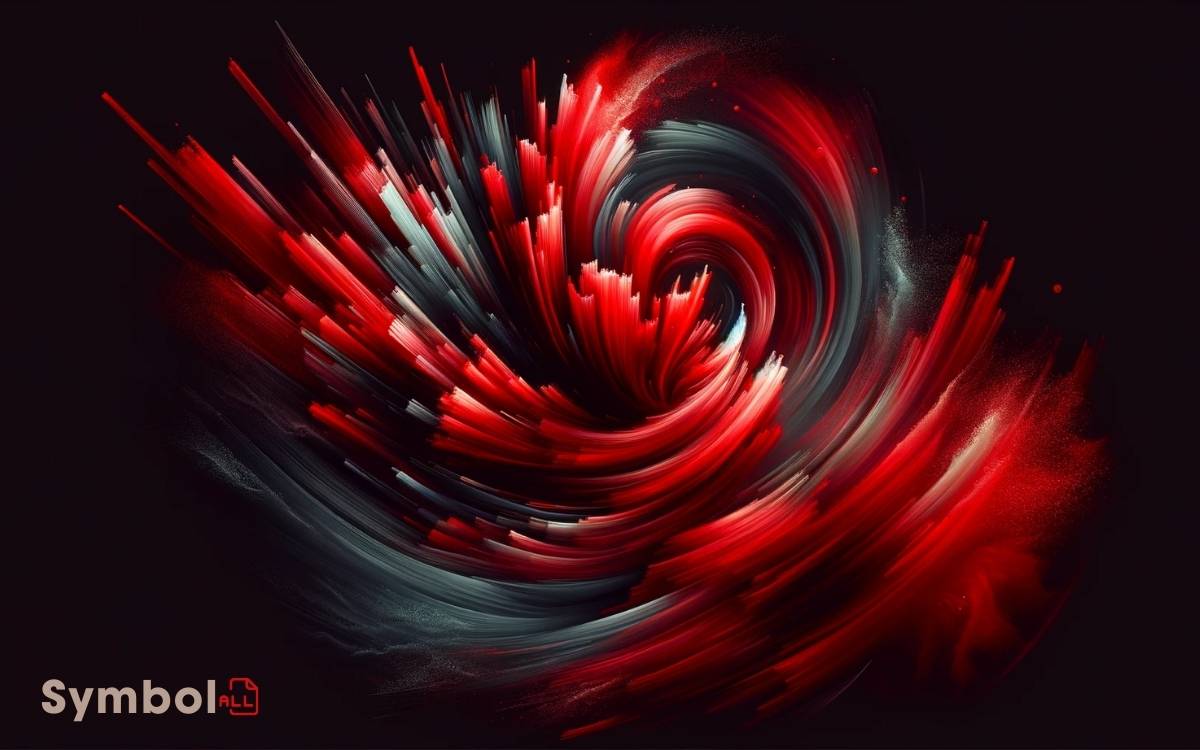Symbolism of the Color Scarlet: A Complete guide!
Scarlet’s not just any color; you’re looking at a symbol loaded with meanings. Historically, it screamed power, wealth, and sacredness due to its rarity and the labor involved in its production. It’s the color of passion, embodying deep emotions, love, and desire.
But there’s a flip side – it also signals danger and commands your attention in warnings. In domains of power and status, scarlet marks authority and social prestige. It weaves through morality, sin, and even religious sacrifices, showing its complexity.
Around the globe, it carries varied symbols from luck to courage. Scarlet’s layers reveal much about human values and emotions, stimulating a keen insight into its symbolic depth.

Key Takeaway
Historical Origins
The historical origins of scarlet’s symbolism are deeply rooted in ancient civilizations, where it was prized for its vibrant hue and rarity.
Scarlet wasn’t just any color; it represented power, wealth, and status. Its production was labor-intensive, involving the use of precious dyes that only the elite could afford. This exclusivity added to its symbolic weight across cultures.
In ancient Rome, scarlet cloaks were worn by generals and later by the emperors themselves, underlining their authority and divine favor.
Similarly, in Medieval Europe, the Church adopted scarlet for cardinals’ vestments, symbolizing their pivotal role and influence.
Across these contexts, scarlet consistently signified not just social prestige but also the sacred and the sovereign.
Passion and Desire
Scarlet’s lively hue also embodies deep-seated emotions, representing passion and desire in a way no other color can.
This shade captures the essence of profound love and fervent yearning, often symbolizing the intensity and depth of romantic feelings.
When you see scarlet, it’s not just a color; it’s an experience, evoking the energy and liveliness of heartfelt connections. It’s the color of the beating heart, the flush of cheeks in a moment of affection, encapsulating the raw, unfiltered essence of attraction.
This connection isn’t superficial; it’s rooted in the human condition, reflecting our innate longing for intimacy and connection. Scarlet doesn’t just signify love; it envelops you in the very sensation of it, offering a visual representation of desire’s purest form.
Power and Prestige
You’ve seen how scarlet signals warning and danger, but it also embodies power and prestige. This hue has historically marked the garments and banners of the elite, symbolizing authority and social status.
Exploring scarlet’s role in visual representation, its prestigious past, and exclusive associations offers a thorough understanding of its potent symbolism.
Authoritys Visual Representation
Throughout history, many societies have leveraged the bold hue of scarlet to symbolize the authority, power, and prestige of their leaders and institutions.
This choice isn’t arbitrary. Scarlet’s visibility and rarity made it a coveted dye, accessible only to the elite.
You’ll find that in the visual representation of authority, scarlet isn’t just a color; it’s a statement. It commands attention, marking individuals and entities as inherently distinguished.
When you see a figure draped in scarlet, it’s clear they hold a position above the ordinary, embodying both the responsibility and the reverence associated with their status.
This deliberate use of color has created a universal language of leadership and distinction, transcending cultural and temporal boundaries to establish a recognizable marker of power and prestige.
Prestige in Historical Context
Building on the idea of scarlet as a symbol of authority, let’s explore how this representation of power and prestige has evolved in various historical contexts.
In ancient civilizations, scarlet was often reserved for the elite due to the rarity and cost of the dye needed to produce such a vibrant color. This exclusivity meant that wearing scarlet became a clear indication of one’s high status and wealth.
As time progressed, the symbolism of scarlet shifted slightly but retained its association with prestige.
In medieval and renaissance periods, for instance, scarlet robes were donned by royalty and high-ranking officials during important ceremonies, reinforcing the color’s enduring link to power.
This historical journey of scarlet illustrates how deeply intertwined color symbolism is with cultural perceptions of prestige.
Scarlets Elite Associations
Scarlet’s elite associations with power and prestige have roots deeply embedded in the annals of history, symbolizing not just wealth but also a distinctive societal stature. This color, vibrant and bold, isn’t just a hue; it’s a statement.
You see, in the tapestry of human culture, scarlet has always signified more than mere luxury. It’s a marker of influence and authority. Think of the red robes of cardinals or the scarlet uniforms of certain military officers.
These aren’t arbitrary choices. They’re deliberate, reflecting a deep-seated acknowledgment of scarlet as a symbol of elite status.
You’re witnessing a color that’s been carefully curated to represent power dynamics, a visual shorthand for hierarchy and privilege that transcends mere fashion or trend.
Sin and Morality
Often, scarlet symbolizes the complex interplay between sin and morality, inviting you to explore how societal norms shape our understanding of right and wrong.
This vibrant color serves as a powerful metaphor, illustrating the often blurred lines between virtue and vice. It’s not just a matter of historical context; it’s about how you perceive and internalize these concepts in your life.
- Perception of Guilt: Scarlet can represent the weight of guilt and the struggle for redemption, highlighting the internal conflict within you.
- Cultural Significance: Across cultures, scarlet carries varying connotations of sin, often dictated by historical and religious influences.
- Moral Ambiguity: It challenges you to question the dichotomy of sin and morality, suggesting that human behavior and ethics aren’t always black and white.
Understanding scarlet in this light invites a deeper contemplation of your values and the societal constructs that define them.
Literature and Myth
When you explore scarlet’s role in classic novels and myths, you’re uncovering layers of symbolism that have influenced emotions and perceptions throughout history.
Scarlet’s vivid hues don’t just captivate the eye; they evoke a deep emotional response, intertwining with themes of passion, danger, and sacrifice across various narratives.
This exploration reveals how scarlet has been a powerful tool for storytelling, enriching literature and myth with its complex symbolism.
Scarlet in Classic Novels
Scarlet weaves its vivid hue through classic novels, embodying passion, sin, and rebellion against societal norms.
This color’s presence in literature isn’t just a detail; it’s a deliberate choice that amplifies themes and emotions, providing depth and complexity to narratives.
By observing how scarlet unfolds in these stories, you gain insights into the characters’ struggles and the societal critiques embedded within the texts.
- ‘The Scarlet Letter’ by Nathaniel Hawthorne: Scarlet embodies shame and societal judgment but also becomes a symbol of identity and resilience.
- ‘Gone with the Wind’ by Margaret Mitchell: The color represents the fiery spirit and determination of Scarlett O’Hara amidst war and personal turmoil.
- ‘Red Badge of Courage’ by Stephen Crane: Here, scarlet illustrates the brutal reality of war and the protagonist’s quest for valor.
Analyzing these examples shows how scarlet’s symbolism extends beyond its initial associations, enriching the narrative and inviting readers to explore deeper meanings.
Myths: Scarlet Symbolism
Diving into myths and literature reveals that scarlet carries complex symbolism, intertwining with themes of love, violence, and divine power across various cultures.
You’ll find that in Greek mythology, scarlet is often associated with the gods, symbolizing both the divine rage of war and the deep love of Aphrodite.
Similarly, in Eastern traditions, scarlet dragons are symbols of strength and luck, embodying both the ferocity and the protective qualities of these mythical creatures.
This color’s ability to signify both life-giving love and destructive violence speaks to its deep-rooted presence in human consciousness.
Scarlets Emotional Impact
Exploring the emotional impact of scarlet in literature and myth reveals its profound ability to resonate with human feelings, bridging the gap between love’s warmth and the chill of violence.
This duality captures the essence of human emotion, where scarlet becomes a beacon of intensity.
- Passion and Danger: In stories, scarlet often symbolizes deep love or imminent peril, reminding you of the fine line between devotion and destruction.
- Power and Rebellion: Scarlet flags and garments in myths signal authority or the courage to defy it, reflecting society’s respect and fear.
- Sacrifice and Purity: Despite its boldness, scarlet can also embody sacrifice, illustrating purity and redemption through its vibrancy.
Scarlet’s emotional impact is thus multifaceted, embodying the complexities of human experiences and the thematic richness of narratives.
Religious Significance
In many religious traditions, the color scarlet holds profound symbolic significance. It often represents concepts like sacrifice, courage, and purification.
This vibrant hue embodies the essence of life’s blood, which is intimately linked with the idea of sacrificial acts central to various belief systems.
It’s a color that conveys the gravity of commitment and the depths of spiritual dedication. In Christianity, scarlet threads weave through narratives of redemption, symbolizing both the blood of Christ and the sins of mankind. This duality in meaning makes scarlet a profound and evocative hue, intertwining themes of sacrifice and human frailty. Similarly, the color red symbolism in scarlet ibis reveals notions of vulnerability and the fleeting nature of life, as the bird’s crimson feathers serve as a poignant reminder of beauty and fragility. Across cultures and stories, the color red stands as a vivid emblem of passion, suffering, and the threads that connect humanity’s shared experiences.
Similarly, in Eastern traditions, scarlet signifies the fiery energy of enlightenment and transformation.
Understanding scarlet’s religious connotations offers a deeper appreciation of its use in rituals and sacred art. It enriches your comprehension of spiritual symbolism.
Cultural Interpretations
Beyond its religious significance, scarlet’s impact permeates various cultures, offering a spectrum of meanings that range from prosperity and joy to warning and danger.
You’ll find that this vibrant color holds a unique place in the hearts and minds of people across the globe, shaped by historical, social, and artistic influences.
- In Chinese culture, scarlet symbolizes luck, happiness, and is a staple in celebrations, particularly weddings.
- Western societies often associate scarlet with power, passion, and sometimes danger, making it a frequent choice for signals that demand attention.
- In literature and folklore, scarlet can signify courage, sacrifice, or even scandal, depending on the context provided by the narrative.
Understanding scarlet in these diverse contexts enriches your appreciation of its profound cultural resonance and the multifaceted meanings it carries worldwide.
Conclusion
So, you’ve traipsed through the vibrant, sometimes sordid, history of scarlet, haven’t you? From its origins steeped in power and the occasional moral panic, to its flirtations with danger and desire.
Let’s not forget how it’s danced through literature and mythology, donning the robes of sinners and saints alike.
Culturally, it’s a chameleon, but let’s be honest, does anyone really see scarlet and think, ‘Ah, yes, the epitome of subtlety‘?
Nope. It’s the color that refuses to whisper, always ready to shout its significance from the rooftops, whether we’re ready to listen or not.






